Multiple Choice Questions on Enzymes – NEET Biology
Question 1. As the temperature changes from 30 to 45’c the rate of enzyme activity will:
- Decrease
- First decrease and then increase
- First increase and then decrease
- Increase.
Answer: 3. First increase and then decrease
Question 2. Which one inactivates an enzyme by changing the enzyme’s shape?
- Non-competitive inhibitor
- Competitive inhibitor.
- Coenzyme
- All the above.
Answer: 1. Non-competitive inhibitor
Question 3. A non-proteinic enzyme is :
- Lysozyme
- Zymase
- Papain
- Rna ase-p.
Answer: 4. Rna ase-p.
Question 4. Which of the following belongs to class 5 of the cubic system of classification of enzymes?
- Isomerase
- Ligases
- Transferase
- Lyases.
Answer: 1. Isomerase
Read and Learn More NEET Biology Multiple Choice Question and Answers
Question 5. Which does inactivate by denaturation in it?
- Allosteric inhibitor
- Competitive inhibitor
- Irreversible inhibitor
- None of the above.
Answer: 1. Allosteric inhibitor
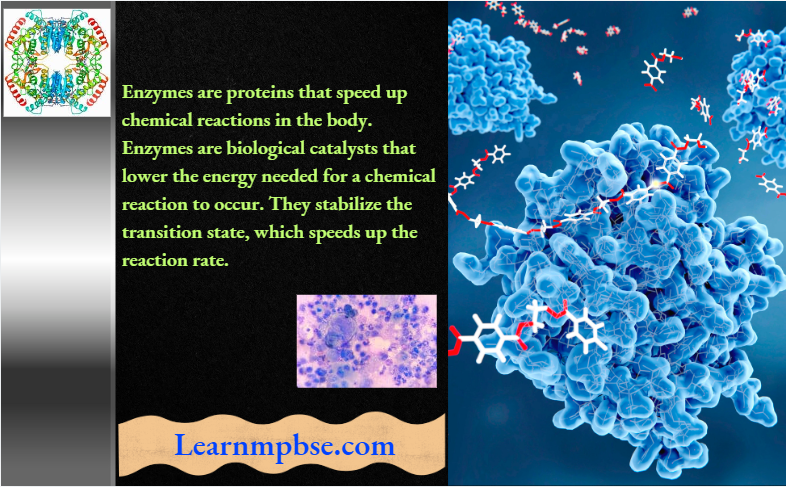
Question 6. Most of the enzymes are secreted in an inactive form, otherwise, they will be destroyed.
- Cell proteins
- Cell dna
- Cell mitochondria
- Cell wall and membrane.
Answer: 1. Cell proteins
Multiple Choice Questions On Enzymes Neet
Question 7. The fastest enzyme is :
- Pepsin
- Trypsin
- Catalase
- Carbonic anhydrase.
Answer: 4. Carbonic anhydrase.
Question 8. Buchner isolated
- Siamese
- Zymase
- Zeatinase
- Ferment.
Answer: 2. Zymase
Question 9. The best example of extracellular enzymes (exoenzymes) is:
- Nucleases
- Digestive enzymes
- Succinic dehydrogenase
- None of the above.
Answer: 2. Digestive enzymes
Question 10. Enzymes bring about hydrolysis of esters and peptides are :
- Transferases
- Lyases
- Hydrolases
- Ligase.
Answer: 3. Hydrolases
Question 11. Examples of amine online are:
- Arginase
- Lactase
- Zymase
- Lipase.
Answer: 1. Arginase
Question 12. Energy must be added to a chemical reaction to start. This energy is known as the energy of :
- Entropy
- Activation
- Enthalpy
- Oxidation.
Answer: 2. Activation
Multiple Choice Questions On Enzymes Neet
Question 13. Which level of ‘x’ represents the usable energy yield?
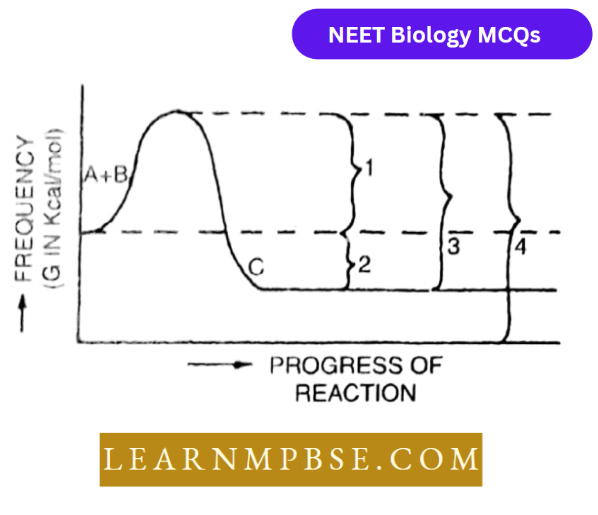
- 1
- 2
- 3
- 4.
Answer: 2. 2
Question 14. Which segment of ‘x’ represents the energy of activation?
- 1
- 2
- 4
- 4
Answer: 1. 1
Question 15. The chemical reaction shown in the world be accelerated by all of the following processes:
- Heating A and b together
- Applying pressure to a and b
- Adding an appropriate catalyst
- Increase the conc. Of c.
Answer: 4. Increase the conc. Of c.
Question 16. In most of the metabolic pathways, all needed enzymes are arranged together, in a multienzyme complex within:
- Solution of atp
- Membrane
- Quarternary protein
- Coenzyme.
Answer: 2. Membrane
Question 17. A non-protein organic part attached firmly to an apoenzyme is called :
- Cofactor
- Activator
- Metallic group
- Coenzyme.
Answer: 1. Cofactor
Enzyme Catalysis Mcqs For Neet
Question 18. Which is an enzyme that joins two segments of replicated dna?
- Ligase
- Lyase
- Endonuclease
- None of the above.
Answer: 1. Ligase
Question 19. Apoenzyrne and coenzyme collective produce :
- Holoenzyme
- Enzyrne-product complex
- Cofactor
- Prosthetic group.
Answer: 1. Holoenzyme
Question 20. Minimum number of amino acids to make an enzyme is:
- 50
- 150
- 500
- 5000.
Answer: 1. 50
Question 21. Fmn and fad are coenzymes derived from :
- Ascorbic acid
- Riboflavin
- Thiamine
- Pyridoxine.
Answer: 1. Ascorbic acid
Question 22. Enzymes differ from inorganic catalysts in having:
- High diffusion rate
- High-temperature requirement
- Proteinaceous structure
- Tendency to become inactivated.
Answer: 3. Proteinaceous structure
Question 23. Active sites of enzymes are composed of :
- Sugm molecule
- Metallic ions
- Organic co-factors
- Amino acids.
Answer: 4. Amino acids.
Question 24. Pepsin best works at :
- Ph 7.00
- Ph 8.5
- Ph.00
- Ph 8.00.
Answer: 3. Ph.00
Enzyme Catalysis Mcqs For Neet
Question 25. Of the following chemicals, the one that is classified as an enzyme is :
- Galactose
- Lipids
- Manganese dioxide
- Protease.
Answer: 4. Protease.
Question 26. Ribozyme is :
- Rna without sugar
- Rna with extra phosphate
- Rna having enzymatic activity
- All of the above.
Answer: 3. Rna having enzymatic activity
Questions Question 27. Allenzymes:
- Are amino acids
- Act best at 60ºc
- Act best at 7 ph
- Are proteins.
Answer: 4. Are proteins.
Enzyme Catalysis Mcqs For Neet
Question 28. At high temperatures, the enzyme is :
- Denaturated
- Killed
- Slightly activated
- Inactivated.
Answer: 1. Denaturated
Question 29. Inorganic catalyst attached to an enzyme is :
- Apoenzyme
- Coenzyme
- Inhibitor
- Activator.
Answer: 4. Activator.
Question 30. Enzymes are polymers of :
- Fatty acids
- Amino acids
- Hexose sugar
- Inorganic phosphate.
Answer: 2. Amino acids
Question 31. One is not correct :
- All enzymes are thermolabile
- All enzymes are biocatalysts
- All enzymes are proteins
- All proteins are enzymes.
Answer: 4. All proteins are enzymes.
Enzymes Mcq For Neet
Question 32. Match the tennis in column 1 with suitable terms in column 2
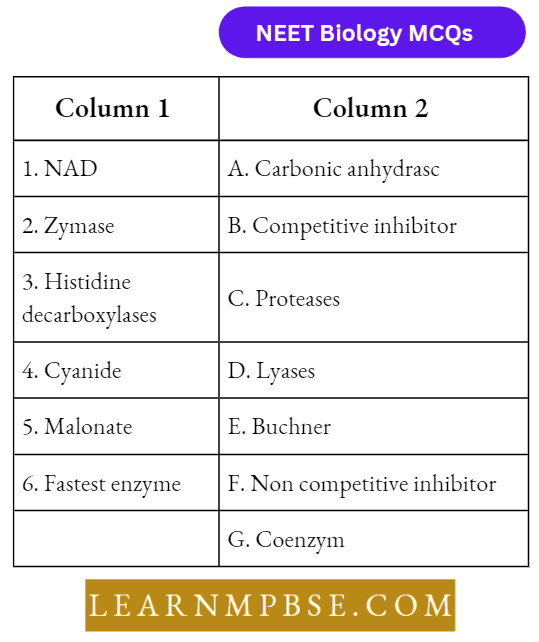
Which of the following is correct?
- 1-G, 2-E, 3-A, 4-B, 5-F,6-C
- 1-G, 2-E, 3-B, 4-C, 5-D, 6-F
- 1-G, 2-A, 3-D, 4-F, 5-B, 6-A
- 1-G, 2-E, 3-D, 4-B, 5-4 5-F.
Answer: 3. 1-G, 2-A, 3-D, 4-F, 5-B, 6-A
Question 33. Modulation:
- Inhibit enzyme activity
- Stimulate enzyme activity
- Function as coenzymes
- Both 1 and 2.
Answer: 4. Both a and b
Question 34. K. Indicates :
- Competitive inhibition
- Denaturation of enzymes
- Reaction velocity
- All of these.
Answer: 3. Reaction velocity
Enzymes Mcq For Neet
Question 35. Which is susceptible to feedback inhibition?
- Zymogen
- Zymase
- Glucokinase
- Hexokinase.
Answer: 4. Hexokinase.
Question 36. Ribozyme was discovered by :
- Kuhne
- Because
- Cech at all
- Altman at all
Answer: 3. Cech at all.
Question 37. An enzyme that brings about a change in side group without altered composition:
- Isomerase
- Epimease
- Mutase
- Esterase.
Answer: 3. Mutase
Question 38. Enzymes functional in cells are:
- Inducible, constitutive, and repressible
- Inducible and repressible
- Inducible only
- Repressible on1y.
Answer: 1. Inducible, constitutive, and repressible
Question 39. Flavoproteins in cellular oxidation are called:
- Splitting enzyme
- Redox enzyme
- Uricolytic enzyme
- Yellow enzyme.
Answer: 4. Yellow enzyme.
Question 40. The presence of enzymes in the urine is called :
- Enzymuria
- Enzymopenia
- Enzymopathy
- None of the above.
Answer: 1. Enzymuria
Question 41. Elisa test used in detecting:
- Antigen
- Antibody
- Hormone
- All of the above.
Answer: 4. All of the above.
Question 42. A person suffering from a.tr.d.s is a resident of an area that is exposed to radio waves which test is preferred to detect h.i.v. Infection.
- R.i.a (radio immune assay)
- H.i.v. Test.
- E.l.i.s.a. Test
- All of the above.
Answer: 3. E.l.i.s.a. Test
Neet Biology Enzyme Classification Mcqs
Question 43. Which of the following curve profiles show changes in the velocity (v) of an enzyme-catalyzed reactions at different pH values :
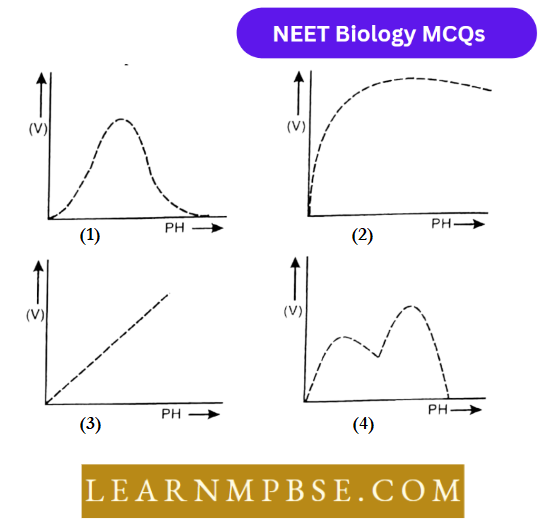
Answer: 1. 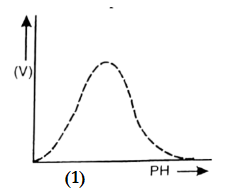
Question 44. According to Koshland:
- The enzyme is never destroyed
- The enzyme is a rigid molecule
- The catalytic site of the enzyme is rigid
- Catalytic sites can be influenced by the presence of substrate.
Answer: 4. Catalytic sites can be influenced by the presence of substrate.
Enzymes MCQ Objective Questions Question 45. According to Michaelis constant, the value of v is expressed as
- [Latex]v=\frac{v_{\max } \times(s)}{k_m+(s)}[/latex]
- [Latex]v=\frac{k_m+(s)}{v_{\max } \times(s)}[/latex]
- [Latex]\mathrm{v}=\frac{\mathrm{v}_{\max } \times \mathrm{k}_{\mathrm{m}}}{[\mathrm{s}]}[/latex]
- [Latex]\mathrm{v}=\frac{\mathrm{k}_{\mathrm{m}} \times(\mathrm{s})}{\mathrm{v}_{\max }} .[/Latex]
Answer: 2. [Latex]v=\frac{k_m+(s)}{v_{\max } \times(s)}[/latex]
Question 46. Enzymes catalyzing the hydrolysis of ester and peptide by the addition of water are known as:
- Transferases
- Hydrolases
- Isomerases
- Oxidation-reduction enzymes.
Answer: 2. Hydrolases
Question 47. Model of fisher implies that;
- The active site is flexible and adjusts to the substrate
- The active site requires the removal of PO, group
- The active site is complementary in shape to that of the substrate
- None of the above.
Answer: 3. The active site is complementary in shape to that of the substrate.
Question 48. C-amp mediated “cascade model” of enzyme regulation was proposed by :
- Fisher
- Sutherland
- Sumner
- Koshalnd.
Answer: 2. Sutherland
Question 49. The substrate combines more rapidly with the enzyme when:
- Km is high
- Km is low
- Ki is high
- Ki is low.
Answer: 2. Km is low
